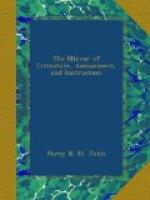In Cockburn’s Voyages we find an interesting account of a tree in South America, which yielded a plentiful supply of water by a kind of distillatory process: this tree was met with near the mountainous district of Vera Paz. The party were attracted to it from a distance, the ground appearing wet around it; and the peculiarity was the more striking, as no rain had fallen for six months previous. “At last,” says he, “to our great astonishment, as well as joy, we saw water dropping, or, as it were, distilling fast from the end of every leaf of this wonderful tree; at least it was so with us, who had been labouring four days through extreme heat without receiving the least moisture, and were now almost expiring for want of it.” The testimony of travellers is too often enshrined among the fabulous; and their credentials either altogether rejected by some, or at least received “cum grano salis.” Bruce of Kinnaird forms the most remarkable example of this kind, and the caricature of Baron Munchausen consigned the whole to sarcasm and ridicule; and yet the time is come when the more remarkable circumstances and phenomena mentioned by this traveller, verified by Lord Valentia, Mr. Salt, &c. are received as well accredited facts. The curious phenomenon mentioned by Cockburn finds an interesting and beautiful counterpart in two plants—namely, the Calla Aethiopica and Agapanthus umbellatus, in both of which, after a copious watering, the water will be seen to drop from the tips of the leaves; a phenomenon, as far as I know, not hitherto recorded.
The great rivers of the continent of Europe have their source of supply in the glaciers; but many of the rivers in the New World owe their origin to the extensive forests of America, and their destruction might dry up many a rivulet, and thus again convert the luxuriant valley into an arid and sterile waste; carried farther, the principle extends to the great features of the globe. What the glaciers effect among the higher regions of the Alps, the Pinus Cembra. and Larix communis accomplish at lower elevations; and many a mountain rivulet owes its existence to their influence. It rains often in the woodlands when it rains no where else; and it is thus that trees and woods modify the hygrometric character of a country; and I doubt not but, by a judicious disposal of trees of particular kinds, many lands now parched up with drought—as, for example, in some of the Leeward Islands—might be reclaimed from that sterility to which they are unhappily doomed.
In Glass’ History of the Canary Islands we have the description of a peculiar tree in the Island of Hierro, which is the means of supplying the inhabitants, man as well as inferior animals, with water; an island which, but for this marvellous adjunct, would be uninhabitable and abandoned. The tree is called Til by the people of the island, and has attached to it the epithet garse, or sacred. It is situated on the top of a rock, terminating the district called Tigulatre, which leads from the shore. A cloud of vapour, which seems to rise from the sea, is impelled towards it; and being condensed by the foliage of the tree, the rain falls into a large tank, from which it is measured out by individuals set apart for that purpose by the authorities of the island.




